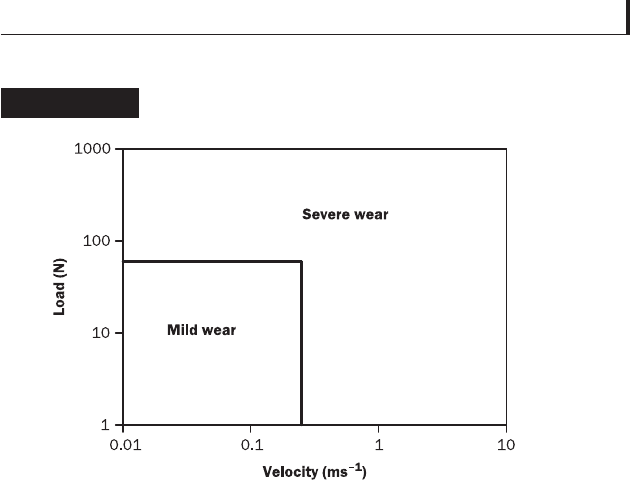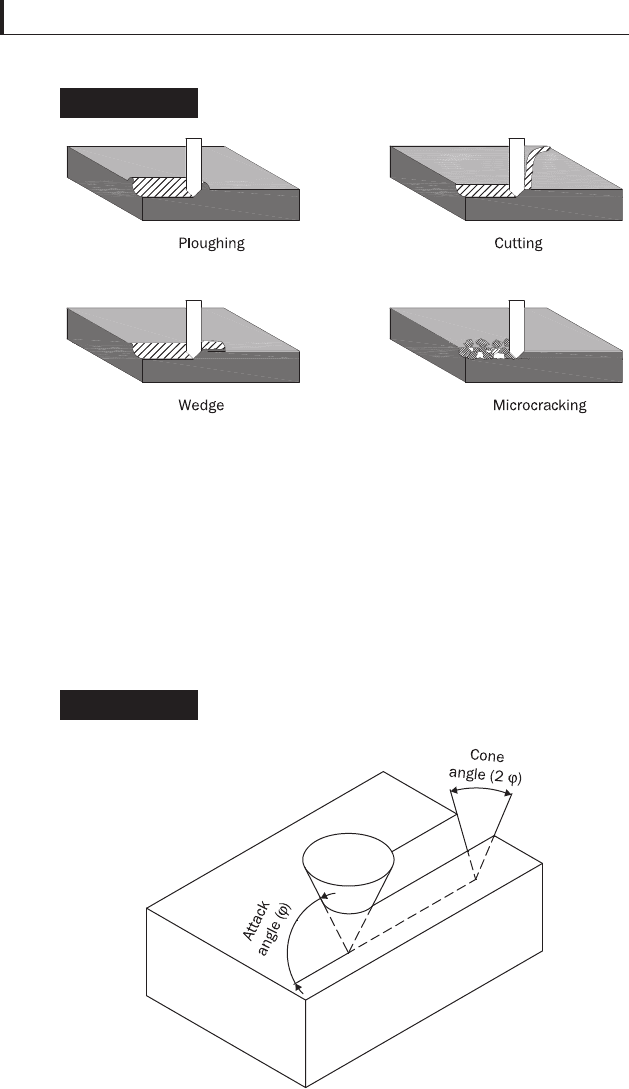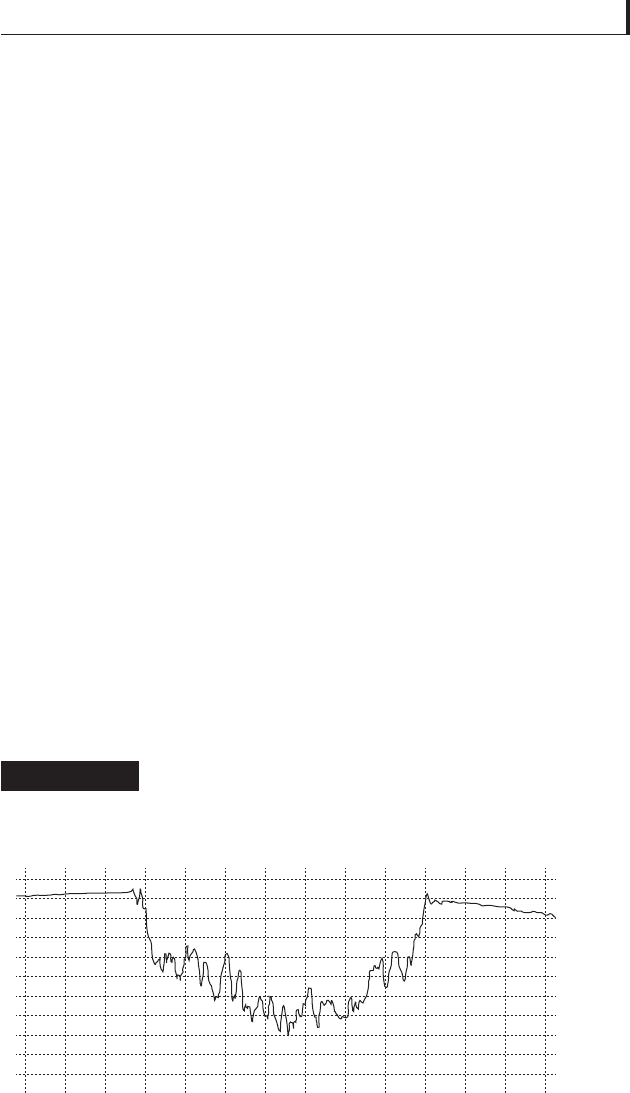Davim J.P. Tribology for Engineers: A Practical Guide
Подождите немного. Документ загружается.


1
2
3
4
5
6
7
8
9
10
10
1
2
3
4
5
6
7
8
9
20
20
1
2
3
4
5
6
7
8
9
30
30
1
2
3
34R
34R
48
Tribology for Engineers
Another assumption of this model is that wear occurs
where surface asperities touch, so the true area of contact is
the sum of all the individual asperity contact areas. For each
individual asperity contact, the maximum contact area for
an asperity of radius a, is
π
a
2
.
Wear takes place when a fragment of material detaches
from an asperity during contact. In this wear model, the
volume of this fragment is presumed to be proportional to
the cube of the contact dimension a, therefore the volume of
this wear fragment can be approximated as 2/3
π
a
3
, for a
sliding distance of 2a.
However, only a fraction
κ
of the contacts generate volume
loss. The wear volume per unit of sliding distance is
[(2/3
π
a
3
)/2a] =
κ
(
A/3) [2.13]
The wear rate is the total volume loss
Q =
κ
/3 = [
(
A)] [2.14]
for the real area of contact between the two surfaces.
The Archard model considers that the deformation of the
asperity contacts is predominantly plastic. This leads to the real
contact area A being proportional to the load and described as
A = W/H [2.15]
where W = applied normal load; H = hardness of the material
that suffers volume loss.
By defi ning the adimensional wear coeffi cient K as
κ
/3, the
fi nal equation results:
Q = KW/H [2.16]
Dry wear coeffi cient values are usually between 10
–2
and
10
–7
. The Archard equation is expressed as
Q = kW [2.17]

1
2
3
4
5
6
7
8
9
10
10
1
2
3
4
5
6
7
8
9
20
20
1
2
3
4
5
6
7
8
9
30
30
1
2
3
34R
34R
49
Friction and wear
where k is K/H, and is called the dimensional wear coeffi cient
or just wear coeffi cient expressed in units of mm
3
(Nm)
–1
.
The wear coeffi cient compares the severity of the wear
damage, but is not suffi cient to account for the mechanisms
which produce wear in each case.
In practice, wear coeffi cients can vary dramatically as the
sliding conditions change. Transient wear rates occur during
the initial or running-in period, while the sliding surfaces evolve
towards their steady-state sliding conditions. For most sliding
systems, no single wear mechanism operates, rather several
mechanisms are present, but their relative importance changes
as the sliding conditions change, with wear rate abruptly
changing when different wear mechanisms predominate. Many
variables infl uence the wear damage processes of metals. Wear
maps have been represented to show how wear rates change
with sliding conditions using dimensionless variables; the
normalized contact pressure has been defi ned as the loading
force divided by the nominal contact area and the hardness of
the softer material; and the normalized velocity, the sliding
velocity, divided by the velocity of heat fl ow.
2.2.2 Fretting wear
Fretting is defi ned as contact between surfaces subjected to
reciprocating motion of low amplitude, while reciprocating
wear occurs at much higher amplitudes. Surface degradation
usually occurs when the amplitude of the displacement is within
the range from 1 to 100
μ
m, giving rise to fretting damage.
Fretting wear involves various wear mechanisms such as
adhesion, abrasion, oxidation and fatigue. At least two
mechanisms occur simultaneously depending on operation
parameters. Fretting wear produces oxidized wear debris and
the wear coeffi cient increases rapidly with increasing amplitude.
One of the main characteristics of reciprocating wear is that

1
2
3
4
5
6
7
8
9
10
10
1
2
3
4
5
6
7
8
9
20
20
1
2
3
4
5
6
7
8
9
30
30
1
2
3
34R
34R
50
Tribology for Engineers
the wear coeffi cients are approximately constant for constant
sliding distance and do not depend on sliding amplitude. The
amplitude value for the transition between fretting and
reciprocating is not easily defi ned as it depends on each set of
experimental conditions and materials (Chen, 2001).
2.2.3 Wear mechanisms
Plastic deformation dominates when metals slide at low
speed. The general requirement for plastic deformation is
that the mechanical stresses generated by the adhesive,
loading and frictional forces exceed the yield stress of one or
both of the sliding materials. Plastic deformation leads to
different surface damage forms:
■
Adhesion. Adhesive forces combined with plastic fl ow pull
out wear particles from the tips of the asperities.
■
Delamination. Plastic fl ow nucleates and promotes the
growth of subsurface cracks that propagate parallel to the
surface, before extending out to the free surface to form
platelet-like wear particles.
■
Surface cracks. For brittle materials, the high tensile
stresses generated by the traction within the contact region
lead to surface fractures and cracks.
■
Fatigue. Cyclic variations of stresses from repeated sliding
or rolling contact results in fatigue failure in the near-
surface region.
■
Mechanical milling and nanostructuring. A mechanically
mixed layer is formed and the composition of wear debris
is a mixture of constituents from the two sliding surfaces.
For unlubricated ductile materials, the grains near the
surface and the wear debris can be refi ned down to the
nanometer level.

1
2
3
4
5
6
7
8
9
10
10
1
2
3
4
5
6
7
8
9
20
20
1
2
3
4
5
6
7
8
9
30
30
1
2
3
34R
34R
51
Friction and wear
■
Seizure. Under extremely high contact pressures, the real
area of contact approaches the nominal area leading to
seizure of the moving parts followed by severe wear when
they move again.
Adhesive wear
The concept of adhesive wear is based on the notion that
adhesion occurs between asperities when they touch,
followed by plastic shearing of the tips of the softer asperities
which then adhere to the opposing surface, and fi nally
separate as wear debris particles (Fig. 2.8). Adhesive wear
can be described by the Archard model. A high surface
energy should result in a high adhesive wear rate, as adhesive
forces are higher for high surface energy. Since surface energy
depends on the chemical composition of the surface, wear
rates from this adhesive mechanism should be very sensitive
to the presence of contamination layers or lubricant fi lm.
Milling of materials is believed to be one of the causes
of tribological surface fi lm formation in sliding contacts.
Besides the transfer and loss of material (Rigney, 2000),
adhesive wear usually involves the following processes:
adsorption of surface layers, i.e. moisture; sub-surface plastic
deformation; microstructural and phase transformations;
and surface fi lm formation.
Model for adhesion, transference of material
and plastic deformation of wear debris
Figure 2.8

1
2
3
4
5
6
7
8
9
10
10
1
2
3
4
5
6
7
8
9
20
20
1
2
3
4
5
6
7
8
9
30
30
1
2
3
34R
34R
52
Tribology for Engineers
After the process of adhesion, transfer and plastic
deformation, wear debris particles produced by adhesive
wear show a fl at rounded morphology (Williams, 2005), as
can be observed in Fig. 2.9. Wear scars on the sliding surface
show plastically deformed material on the edges of the track
(Fig. 2.10 and Fig. 2.11).
Figure 2.10 shows a three-dimensional surface topography
profi le of a wear scar showing accumulation of plastically
SEM micrograph of an adhesive wear debris
particle showing the fl at rounded morphology
Figure 2.9
Three-dimensional surface topography profi le of
a dry wear scar
Figure 2.10
m
m
m

1
2
3
4
5
6
7
8
9
10
10
1
2
3
4
5
6
7
8
9
20
20
1
2
3
4
5
6
7
8
9
30
30
1
2
3
34R
34R
53
Friction and wear
deformed material at the edges and the initiation of cracks
perpendicular to the sliding direction. This wear mechanism
produces an increase of the average roughness (R
a
) inside the
wear track with respect to the initial roughness outside the
track.
The line-scan of the cross section of the wear track shown
in Fig. 2.11 allows to determine the loss of material by
measuring the area of material removed from the track
surface (A
1
) and the plastically deformed material (A
2
+ A
3
).
The fi nal amount of material lost by wear (A
T
) will be
A
T
= [ A
1
– (A
2
+ A
3
)] [2.18]
For metals sliding in air, adhesive wear can be reduced by the
presence of a monolayer of boundary lubricant which not
only reduces the surface energy but also resists displacement
by the contacting asperities, thus preventing the direct
contact between the metals.
Wear maps
Lim and Ashby (1987) developed a wear map for steel sliding
against steel under a pin-on-disk confi guration (Fig. 2.12).
The map establishes the pressure-velocity regions where
different wear mechanisms prevail and under relatively low
pressures and velocities, material removal by delamination
takes place. Mild oxidational wear occurs when oxidation
due to frictional heating is relatively low, but under severe
Line-scan of the cross-section of a wear scar
Figure 2.11

1
2
3
4
5
6
7
8
9
10
10
1
2
3
4
5
6
7
8
9
20
20
1
2
3
4
5
6
7
8
9
30
30
1
2
3
34R
34R
54
Tribology for Engineers
oxidational wear, wear particles are removed exclusively
from the oxide layers. Melt wear occurs when fl ash
temperatures reach the melting point. This map for steel was
the precedent for other wear maps such as that developed by
Adachi et al. (1997) for ceramic materials (Fig. 2.13).
In the case of ceramics, a quantitative model for the
transition from mild to severe wear was developed from
experimental data of ceramics sliding against themselves
under the pin-on-disc confi guration.
Abrasive wear
In abrasive wear, the rubbing of hard particles or hard
asperities against a surface removes or displaces the material
Load-velocity wear map for steel–steel under
pin-on-disc confi guration
Figure 2.12
Adapted from Lim and Ashby (1987).

1
2
3
4
5
6
7
8
9
10
10
1
2
3
4
5
6
7
8
9
20
20
1
2
3
4
5
6
7
8
9
30
30
1
2
3
34R
34R
55
Friction and wear
from that surface (Hokkirigawa and Kato, 1988). For
abrasive wear to occur these particles, or one of the contacting
surfaces, needs to be considerably harder than the surface
being abraded (at least 1.3 times harder). The abrasive wear
process leads to a characteristic surface topography of long
grooves running in the sliding direction. The two general
types of abrasive wear are:
■
Two-body abrasion: Wear is caused by the hard protrusions
of one surface on the other. Cutting tools produce two-
body abrasive wear (Fig. 2.14).
■
Three-body abrasion: Wear is caused by hard particles that
slide between two sliding surfaces. This includes abrasion
by wear debris generated by other wear mechanisms.
A simple way to model the abrasive wear (Siniawski et al.,
2006) of an asperity in a two-body process or the corner
of a grit particle in a three-body process is to consider a cone
of a hard material gouging a groove into a softer material
Wear map for Al
2
O
3
Figure 2.13
Adapted from Adachi et al., 1997

1
2
3
4
5
6
7
8
9
10
10
1
2
3
4
5
6
7
8
9
20
20
1
2
3
4
5
6
7
8
9
30
30
1
2
3
34R
34R
56
Tribology for Engineers
(Fig. 2.15). If the depth of the groove is x and the slope of the
side of the cone is tan
θ
(Fig. 2.15), the volume V of material
displaced when the asperity slides a distance d is given by
V = dx
2
tan
ϕ
= dx
2
cot
θ
[2.19]
where 2
ϕ
is the cone angle of the indenter.
Abrasive wear mechanisms by a sharp indenter
Figure 2.14
Abrasive wear by a cone-shaped asperity
Figure 2.15

1
2
3
4
5
6
7
8
9
10
10
1
2
3
4
5
6
7
8
9
20
20
1
2
3
4
5
6
7
8
9
30
30
1
2
3
34R
34R
57
Friction and wear
Since only the front half of the asperity applies a load W
over an area
π
a
2
/2, then
W =
1
/
2
H
π
a
2
=
1
/
2
H
π
h
2
cot
2
θ
[2.20]
where H is the hardness of the softer material. From the
above equations, the wear rate for abrasive wear (Q
a
) will be
Q
a
= V/d
= 2tan
θ
W/
π
H [2.21]
and the coeffi cient of abrasive wear (K
a
) would be 2/
π
(tan
θ
).
In contrast with the wear track profi le seen in Fig. 2.11,
abrasive wear produces parallel grooves inside the wear
track (Fig. 2.16) without plastic deformation, and the
morphology of wear debris particles (Williams, 2005)
produced by abrasion (Fig. 2.17) is similar to that of the
chips removed by machining operations. In most cases,
however, a combination of adhesive and abrasive mechanisms
is found due to the abrasion produced by the wear debris
trapped in the interface between the sliding solids.
Scratch tests were developed to measure the resistance to
abrasive wear of coatings. In the case of viscoelastic materials
such as polymers (Brostow et al., 2002; Dasari et al., 2009),
Abrasive wear scar profi le obtained by contact
profi lometry, showing abrasion grooves inside
the scar and the absence of plastic deformation
at the edges
Figure 2.16
